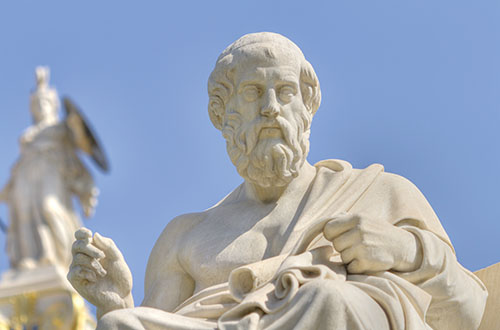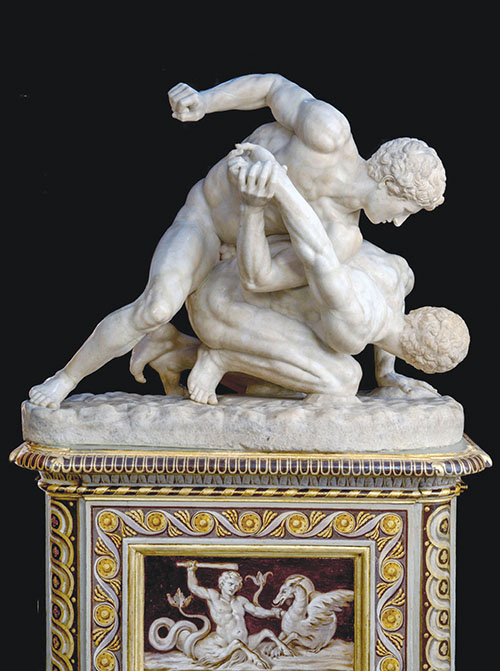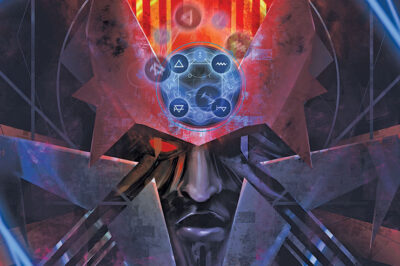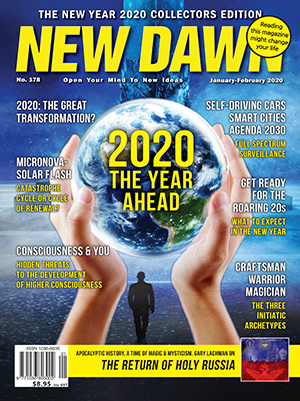From New Dawn 178 (Jan-Feb 2020)
When Pierre Boulle wrote his novel La Planète des singes during the early 1960s, he had undoubtedly observed the strange division of mind and body in modern, Western society, reflecting it in the novel that would be made into the first ‘Planet of The Apes’ movie, released in 1968. The movie showed us a world run by apes and an ape society divided into several castes, each with their own function: chimpanzees (scientists), gorillas (military and police), and orangutans (politicians or leaders). Probably unintentionally, Boulle had invoked and reimagined the archetypes that lie at the base of human civilisation – the Craftsman, Warrior, and Magician. But he had noticed something else.
In the ‘Planet of The Apes’, the differences between the strong, militaristic gorillas and the effeminate, intellectual chimpanzees caused a split in society, and there is suspicion on both sides. This must have resonated with an America then at war in Vietnam and experiencing protests against the war at home. In the year before the movie’s release, during the March on The Pentagon, protesters had held out flowers to 2,500 army national guard troops or placed them into the barrels of soldiers’ rifles. As a reflection of human society, the ‘Planet of The Apes’ was, then, too early to notice the extraordinary aggression of the intellectual class – an aggression that matches that of the military class, but which is directed against the intellectuals’ own society rather than towards an external enemy.
In such a society, theories dominate facts and ideas dictate reality. The health profession might tell us that, like anorexia, obesity is associated with serious health risks, but to point this out in public might be considered “sizeism” or “hate speech.” In America, a few years ago, there was an attempt to convince the public that “lookism” was the new racism. According to this theory (which is still believed by many activists), since we are attracted to beauty but not so much to ugliness, beauty is oppressive since it must be socially constructed.1 If beauty in women is suspicious in the current era, so, of course, is physical strength in men. In 2017, Bedfordshire police tweeted a meme that associated going to the gym with right-wing extremism.2 And we can probably all think of increasingly popular theories that tell us our natural bodies are really little more than lumps of Play-doh that, even during childhood, can be manipulated through drugs and surgery into new, interesting shapes, which will allegedly represent who we really are – or say we are.
Three Archetypes
In a time of confusion, an increasing concern with safety, increasing disbelief in the transcendent, and increasing imbalance in individuals and in society as a whole, we have more to learn from the archetypes of the craftsman, warrior, and magician than ever before. But why not other archetypes?
Over recent decades, everything from marketing to movie analysis has been influenced by psychoanalyst Carl Jung’s notion of archetypes. And various new groupings of archetypes have become established (e.g., the marketing industry’s twelve “brand archetypes”). Claimed to represent the authentic, primordial nature of human beings, some of these proposed “archetypes” don’t have any significant role in ancient myths (perhaps Jung’s primary source for exploring archetypes) or any role in early human (or even later human) culture. The innocent, the orphan, jester, and lover all show up as “archetypes” in some theories. Yet, there has never been a tribe or society of jesters, warriors and lovers, for example.
When we look at ancient cultures, we do – as comparative philologist and mythologist Georges Dumézil claimed – see the craftsman, warrior, and magician clustered together over and over again. According to Dumézil, these constituted the three original classes or castes among Indo-European societies and, as such, spread across Europe, India, Persia and elsewhere – though, ultimately, we find these castes across the globe.
Whether we believe the existence of these three castes to be the result of archetypes impressing themselves upon the consciousness of society or whether we think it is due to historical links between ancient India and Greece, for example, it is certain that (in contrast to other groupings, which are purely arbitrary – jester, warrior, lover, for example) no society has ever been able to survive without craftsmen (blacksmiths, farmers, etc.), warriors, and magicians (village elders, guides, spiritual and intellectual leaders, etc.).

While it is not surprising to find these in primitive society, it is surprising that this group reappears later on, in both East and West. The ancient Greek philosopher Plato was not only initiated into the Mysteries but was known for his skill in wrestling (his name means literally “broad-shouldered”). He taught that not only was philosophy (the magician archetype) necessary but so too was the study of music (craftsman) and physical discipline (warrior). Again, Miyamoto Musashi, Japan’s most famous warrior, spent years meditating in a cave (magician archetype) and was also known for his skill in painting, calligraphy, and gardening (craftsman). And from Confucian to classical Western education, inevitably there is a mix of the study of philosophy, ritual, and religion (magician), music, calligraphy, painting (craftsman), and fencing, wrestling, boxing, or physically demanding and dangerous sport (warrior).
Again, around the 12th century CE, Sufi Orders were not only influenced by Islamic chivalry (futuwwa) but began to structure themselves after the trade guild, with disciples becoming apprentices (mubtadi’), companions (sani‘), and master craftsman (mu‘allim). Roughly six hundred years later, in England, the fraternity of the Free Masons (or Freemasonry) separated from the stonemasons trade guild of Great Britain. It expanded upon the two initiation rituals of the stonemasons guild and added a third so that, in the “Craft Masonic Lodge,” a Freemason would become an Entered Apprentice, then a Fellowcraft, and finally a Master Mason.

There are also hints of chivalry in the degrees of Craft Freemasonry. The white apron, presented to every Freemason, is described in the Masonic ritual as “more honourable than the Star and Garter” – a reference to the knightly, or chivalric, Order of the Garter. However, the warrior – or more specifically the knight – is more pronounced in the so-called “higher degrees” of Freemasonry. When the Masonic fraternity spread across France and Germany a decade or so after the founding of the premier Grand Lodge in London, in 1717 CE, Masonic enthusiasts began creating new degrees. Some were influenced by alchemy, Hermeticism, or Rosicrucianism but nearly all of them were influenced by Christian chivalry.
Although probably not aware of the division in ancient culture into craftsmen, warriors, and magicians, in his book Masonic Temples historian William D. Moore argued that American Freemasonry came to embody the craftsman, holy warrior, and mystic. For Moore, the Craft Masonic Lodge embodies the craftsman archetype, the Masonic Order of the Temple (or “Knights Templar” degree) embodies the warrior, and the Scottish Rite degrees of Freemasonry embody the magician.
Just as we find three levels or degrees in Sufism and Freemasonry, anthropologist David W. Anthony has suggested that, in antiquity, the vocations of craftsman, warrior, and magician (sage, priest, or elder, etc.) constituted “three age grades,” with a man passing from being a craftsman in his youth (in premodern cultures people often began work at around five or six years of age or younger), becoming a warrior during his years of peak physical strength, and a magician or tribal leader in older age. Certainly, the progression makes sense. No normal society, after all, would want old men for its protection or children for its leaders. Yet, embodying both early human society and an archetypal progression from childhood to adulthood, and from labour to spiritual guidance, perhaps it was inevitable that the craftsman, warrior, and magician (and not the jester, warrior, lover, for example) would re-emerge in later societies intended to initiate men, in particular, into manhood and into a transcendent reality beyond the daily grind.
Incorporating the Archetypes into Your Life
However, like Plato and Musashi, we do not have to wait to pass from one archetype to the next. Instead, as the classical education of the East and Wests suggests, we can, and should, find ways to incorporate them into our lives right now. This is especially important today. Balanced with craftsmen, warriors, and magicians or spiritual guides, ancient society was holistic, whole; the body, brain, and spirit were balanced. Today, however, the mind and body is so severely split in the West that we have come to see the physical body as something that has no objective reality beyond what the mind (i.e., the latest intellectual theory) says it is. And as religion has declined in the West, so has a sense of the sacred and the transcendent. Yet, religious fervour is alive and well in politics. If we openly question the latest pronouncements of the political priest caste, we will be denounced as heretics.

How can the craftsman, warrior, and magician archetypes help us? While there are differences between them, there are, as we have suggested, also connections and overlaps. In many ancient, tribal societies, blacksmiths acted as priests or shamans, performing special rites and initiating new members into the metallurgist’s craft. The warrior, too, had his spiritual rites and traditions. In India, a shrine to the goddess Kali is kept in the traditional temple of the martial art of Kalaripayattu. In Iran, the martial tradition of Zoorkhana was strongly influenced by Sufism and Shi’ite Islam. Shaolin Kung Fu comes from the Buddhist Shaolin monastery. Again, Zen Buddhism became associated with the Samurai as well as with martial arts such as Kendo and Karate-do, and yet Zen was also taught through, or embodied in, the crafts or arts of painting, calligraphy, flower arranging, and even serving tea (chado). Unsurprisingly, perhaps, the late Samurai manual the Hagakure tells us that if a practitioner of a Way (a Do or Tao) should see another practice of the Way, he should understand his own even more clearly.
Despite what our education and employment systems currently push, we must not get stuck in one specialisation or one limited way of thinking. In most cases, although finding a niche might work, it is likely to work only for a limited amount of time, especially in a fast-changing world. Flexibility is necessary. Moreover, even today, leaders in any field think outside the box and bring different, seemingly incompatible things together. (Think of Steve Jobs introducing different fonts to computers inspired by his study of the ancient art of calligraphy under a Trappist monk.) Specialisation, or compartmentalisation, is an even bigger problem when it comes to our own lives. At best, it encourages us to become a fraction of who we could be. In most cases, it turns people into hobbyists, obsessive consumers of sports tv, or spiritual fantasists and pseudo-intellectuals with an overblown sense of their moral goodness and everyone else’s wickedness.
Instead, as I advocate in my book The Three Stages of Initiatic Spirituality: Craftsman, Warrior, Magician, we must cultivate the mind, body, and spirit – practicing some kind of art or skill, training our bodies, and having some kind of spirituality. For Plato, this meant music, wrestling, and philosophy. For us, it could mean anything from painting, writing, poetry, customising motorbikes, to learning to cook traditional, healthy food (craftsman); working out at a gym, practicing a martial art, or doing Spartan races, etc. (warrior); and practicing meditation, positive thinking, some kind of spiritual or religious ritual, or studying the symbols, myths, and archetypes embodied in the world’s ancient cultures (magician).
How We Got Where We Are Today
How did we get from the tribal and ancient society where its craftspeople, warriors, and magicians or elders and spiritual leaders were in harmony, to one where the different factions are at war with each other and, in some cases, at war with their own societies? Estrangement from nature might be one reason. A lack of knowledge about the past might be another. But, undoubtedly, from the Industrial to the post-Industrial era, specialisation in education and work has played a role. We do and cannot move from becoming accomplished in an art or craft, to becoming a warrior, to finally becoming a guide for the community.
Mythology and ancient sociology explain the transformation of society in another way. There are two contrary sets of myths that we must consider. According to one set of myths, the world and the quality of humanity is in decline, becoming ever less spiritual and ever more materialistic and self-centred. According to the other set of myths, there is natural and perhaps unstoppable progress. The former group of myths tend to focus on the society (society is in decline) whereas myths of progress tend to focus on the individual (the individual has more freedom and can be more creative).
One of the earlier myths of humanity’s progress was created by Joachim of Fiore (c. 1135–1202). Joachim was the founder of his own monastic Order and one of the most important historical and apocalyptic theorists of the medieval period. He conceived three great Ages: the Age of the Father, the Age of the Son, and the Age of the Holy Spirit. Accordingly, in the first of these Ages, people lived under the Law and served God. During the second Age, people lived under the Gospel though Christ had given freedom to mankind. Only in the last Age, however, would there be full freedom. A similar scheme is given by the English occultist Aleister Crowley (1875–1947), who conceived of time as divisible into the Aeons of Isis, Osiris, and Horus, with humanity finally acquiring freedom and individuality in the last.
In contrast, according to Hindu tradition, there are four great Ages or Yugas, beginning with the Satya Yuga (the Age of Truth) and ending with the Kali Yuga (the Dark Age). Likewise, the ancient Greek poet Hesiod claimed that the gods made several “races.” The first of these was a golden race of people. They were in harmony with nature and with each other, and lived long, healthy lives. Then came a silver and a bronze race and finally an iron race. And, again, Norse myth says that in the early days of the earth the gods had plenty of gold (signifying a Golden Age). At the end, however, there is the cosmic war between the gods and giants. In all three myths, the final era was – or will be – described in almost identical terms: Brother will fight with brother; parents will be disrespected; men and women will get together only because of sexual desire; powerful and corrupt men will be respected.
Although not concerned with these myths, Ibn Khaldun would claim that such a decline was quite real. Born in Tunis in 1332, Ibn Khaldun is often considered the father of sociology. During his lifetime, he witnessed dynasties rise and fall across North Africa. Reflecting on this, he claimed that every dynasty goes through three stages. In the first stage, a warrior band swoops down upon a kingdom, defeats it, and takes it over. In this first stage, the warriors, though victorious, stay true to the desert values. They care nothing for luxury, and sleep on the floor. In the next stage, the people enjoy the luxury of the kingdom but hope for a return to a more rugged way of life, which they admired. In the final stage, the people love luxury, are weak, and seek protection from the ruler. Incapable of their own defence, a new warrior band swoops down and conquers them, beginning the cycle again.
We might find a picture of our own civilisation somewhere in Ibn Khaldun’s scheme. Wherever we might locate ourselves in it, the implication is surely that neither luxury and safety nor the warrior alone is enough to make, or sustain, a civilisation. Instead, as we find in perhaps every successful pre-modern society, it requires the harmonious relationship of the craftsman, warrior, and magician. If the civilisation around us cannot manage it, individually we can, and must, embody and unify these archetypes within our own lives.
The Three Stages of Initiatic Spirituality: Craftsman, Warrior, Magician is available from all good bookstores.
Footnotes
1. www.businessinsider.com.au/lookism-is-real-and-could-be-costing-you-your-dream-job-2013-8
2. www.dailycaller.com/2017/07/30/police-link-meeting-someone-at-the-gym-to-right-wing-extremism/
© New Dawn Magazine and the respective author.
For our reproduction notice, click here.



